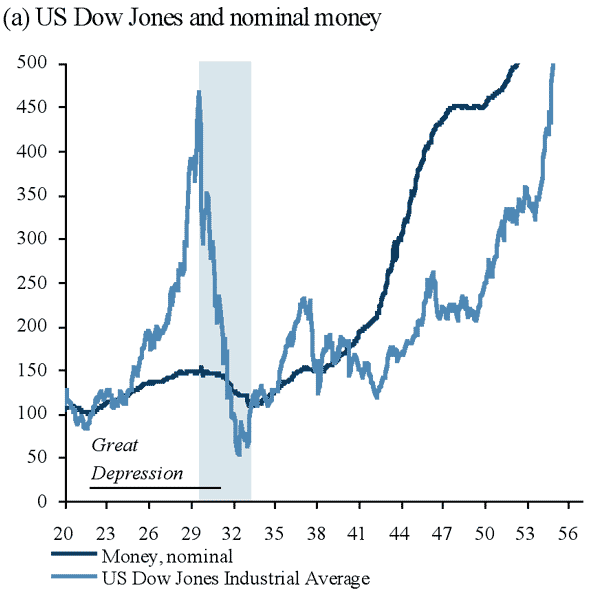The Dark Side of the Credit Boom
Economics / Liquidity Bubble May 19, 2007 - 11:29 AM GMTBy: mises.org
"The bright side of the credit boom is an apparently expanding economy. Sooner or later, however, the boom is going to show its dark side. The gap between the credit and money induced increase in demand for and supply of resources becomes obvious."
by Thorsten Polleit
I. Introduction
Under today's government-controlled paper-money standards, the world's major economies have embarked upon an unprecedented expansion of credit, starting in the early 1980s. As credit growth has been outstripping economies' rise in output, total debt levels in percent of gross domestic product (GDP) have increased strongly.
Take, for instance, the US. Figure 1 (a) depicts total debt and its constituent components in percent of GDP for the period 1960-Q1 to 2006-Q4. Total debt rose from 142% at the beginning of the 1960s to nearly 331% at the end of 2006. Excluding the domestic financial sector - which expanded from 5.6% to 105% - the debt ratio increased from 136% to 226%.
Figure 1 (b) depicts US interest rates in percent, namely the 3-months rate, the 10-year US Treasury yield and Moody's long-term average corporate bond rate. Yields increased strongly from the 1960s until around the early 1980s. Since then, rates have been trending downwards; at the end of 2006 they had returned to levels seen last in the middle of the 1960s.
Figure 1 (c) plots measures of total US debt costs in percent of GDP, calculated on the basis of the aforementioned interest rates. According to this representation, the cost of debt stood between 15 to 19% at the end of 2006, roughly the same level seen at the end of the 1970s - even though the debt ratio had more than doubled since then. Needless to say, the decline in interest rates can be held responsible for this result.
Finally, Figure 1 (d) shows real interest rates and real GDP growth in percent. In the period 1980 to 2006, annual average GPD growth was around 3.0%, whereas real rates stood between 3% (using the 3-months rate) and 6.1% (using the average corporate bond yield). Such a result would suggest that a growing share of the productive sector's current income has been used for paying interest.
Figure 1. - US debt and interest payments in percent of GDP, 1960 to 2006
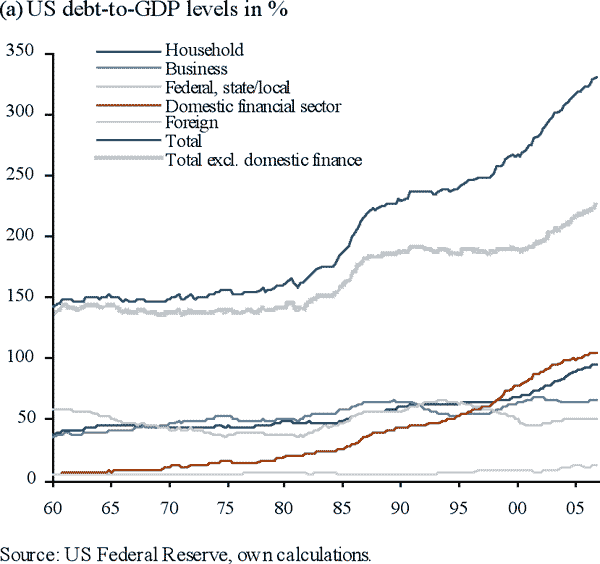
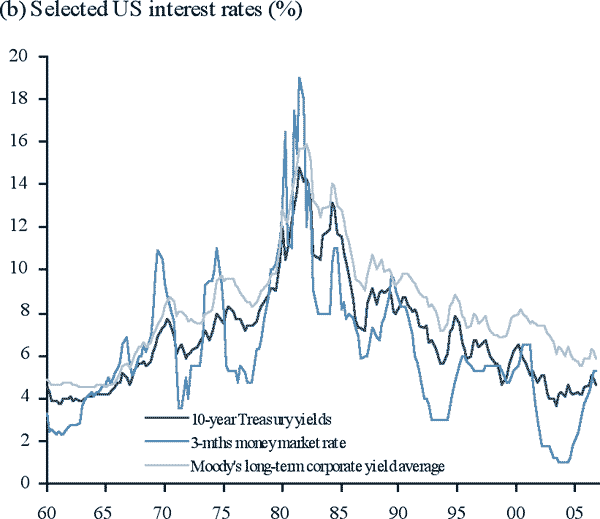

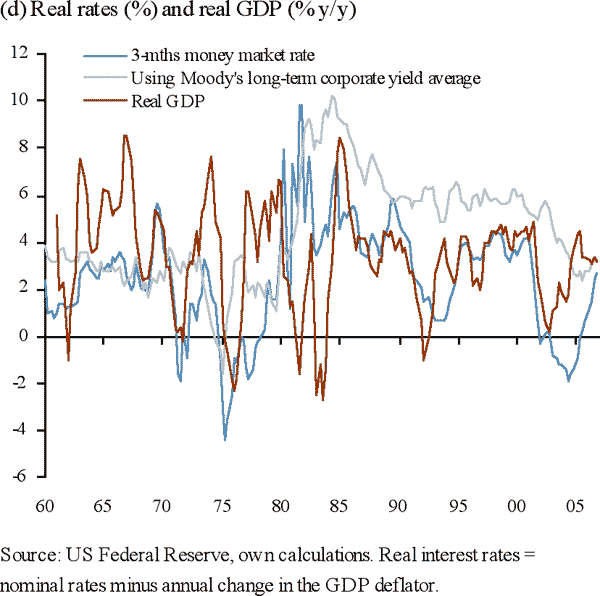
To be sure, the increase in debt-to-GDP ratios over time, accompanied by declining market yields, can actually be observed in all major currency areas, not only in the United States. In any case, such a finding must raise the question about the sustainability of the ongoing credit expansion process. Taking a look at the mainstream economic literature, an economy's debt-to-GDP ratio increase might be explained by two factors.
First, there is "financial deepening": the level of financial intermediation rises as the economy develops, and, as a result, the debt-to-GDP ratio increases. From this viewpoint, growing debt ratios may be seen to be economically trouble-free. Second, there is the issue of "excessive credit expansion": borrowers simply take on too much credit, and this spells danger as rising debt ratios indicate that borrowers will default (sooner or later).
Against this backdrop the crucial question is: where is the borderline between a "good" and "bad" rise in debt-to-GDP ratios? To Austrian economists the ratios spell danger. They maintain that today's government-controlled paper-money systems have decoupled credit expansion from the economies' productive capacities: "circulation credit" feeds a "credit boom" that is doomed to end in severe economic, social and political crisis. Austrians fear that the collapse of the credit boom will lead to the destruction of the currency through a deliberate policy of (hyper-)inflation, destroying the free-market order.
In contrast, today's mainstream monetary economics shows relatively little interest in dealing with the issue of the economically sustainable credit supply. If anything, it focuses on the potential consequences that the collapse of a credit boom might entail - such as recession and deflation as witnessed in, for instance, Japan in the early 1990s or, most traumatically, in the period of the "Great Depression," 1929-1933.
This article elaborates on causes and consequences of the ongoing increase in credit supply and debt-to-GDP ratios. It begins by showing what the Austrian Monetary Theory of the Trade Cycle has to say about this issue (II). Then, the sustainability of rising debt-to-GDP ratio will be briefly discussed (III) and the economic rationale for the widely preferred increase in credit supply examined (IV). In this context, the emergence of credit derivative markets shall be put into perspective (V). Finally, after taking a brief look at the value of money during and after the "Great Depression" (VI), the article concludes with outlining the Austrian recommendation for returning to free market money (VII).
II. The Austrian Theory of the Trade Cycle
To Austrians, the central bank, the agency of the government's money-supply monopoly, would sooner or later, pressed by "public opinion," pursue a policy of artificially lowering the interest rate, thereby increasing circulation credit and money supply. This, in turn, sets the economy on a fatal path of recurrent boom and bust and rising debt-to-GDP ratios that will eventually pave the way towards a policy of deliberately debasing the currency through (hyper-)inflation.
Ludwig von Mises, with recourse to Knut Wicksell's work in 1893 and 1898, assumed that government-controlled central banks would lower market interest rates below the economy's neutral interest rate. With borrowing costs thus reduced, market agents embark upon debt-financed spending. The increase in credit and money supply seems to make disappear, at least temporarily, the law of scarcity. It induces market agents to pursue investment projects for which the economy simply does not have the required resources.
The bright side of the credit boom is an apparently expanding economy. Sooner or later, however, the boom is going to show its dark side. The gap between the credit and money induced increase in demand for and supply of resources becomes obvious. Investment projects, which were deemed profitable, become economically unviable. Hoped-for output and employment gains fall short of expectations, and the economy falls into recession. A decline in output, socially undesirable as it might be, would be the economically needed adjustment process, changing relative prices of goods and services, thereby allowing the economy to converge back to equilibrium.
Confronted with output and employment losses - the fallout of a monetarily induced boom - and a public sense of crisis, central banks are called upon to lower rates from prevailing levels, as such a measure is widely believed to put an end to the crisis and orchestrate an upswing. Giving in to such demands, credit and money supply rises even further. Monetary policy simply perpetuates - and thereby aggravates - existing disequilibria. Repeated again and again, the inescapable crisis is postponed to a future point in time. However, such tactics cannot avoid the final collapse of the monetary system, it only increases the costs of the final crisis.
III. On the sustainability of debt-to-GDP ratios
The Austrian Monetary Theory of the Trade Cycle offers a political-economic explanation of why an economy's debt-to-GDP ratio may rise over time: output gains fall short of the government-sponsored circulation credit growth rate. With this in mind, it might be insightful to briefly recall the so-called "debt dynamics."
If an economy's debt-to-GDP ratio is allowed to rise further and further, interest rates must keep declining so that borrowers do not default on their debt. In the short-run, lower rates might prevent widespread bankruptcy. However, a policy of pushing interest rates down would by no means offer a solution to the underlying problem.
In fact, an artificial lowering of interest rates through the central bank would represent the very process that Austrians consider a perpetuation of the fateful expansion of circulation credit that must end in a collapse of the monetary system.
Is there a chance that an economy's debt-to-GDP ratio can be kept constant at some point (or make it decline from a certain level)? For doing so, circulation credit growth must no longer exceed (that is, decline below) nominal GDP growth. However, if credit expansion slows down (either declines to or below the rate of output expansion), the economy, after having been fueled by years of circulation credit expansion, would almost certainly be heading for recession, which would most likely be accompanied by a further increase in the debt-to-GDP ratio.
Perhaps most important, Austrians suggest that abandoning the current path towards rising debt-to-GDP ratios is a rather challenging task. This is because the ongoing lowering of interest rates and the accompanying rise in circulation credit and debt-to-GDP ratios - the characteristic features of today's state-controlled paper-money systems - is driven by a deep-seated anti-capitalist ideology.
IV. The attractiveness of credit
Mises wrote that public opinion is: "[…] guided by the idea that the height of interest rates as the free loan market determines it is an evil, that it is the objective of a good economic policy to lower it, and that credit expansion is an appropriate means of achieving this end without harm to anybody but parasitic moneylenders. It is this infatuation that causes them to embark upon ventures which must finally bring about the slump."
Mises's words suggest that the power of the masses over credit and money supply, which it wields under a government-controlled money-supply monopoly, brings about a "collective dilemma." Indeed, taking a closer look at the economics of credit transactions, it is not surprising that a government-controlled money system is most likely to embark upon a relentless expansion of credit and money supply.
To show this, assume a lender (say, a private individual) wants to transfer current consumption to future periods. To do so, he or she invests US$100 in cash in a corporate bond (balance sheet I). On the basis of the investor's individual discounting rate the present value (PV) of the bond's future cash flows will amount to, say, US$110. As a result, the transaction increases the lender's net PV (net wealth) by US$10.
The borrower, in turn, receives US$100 in cash and records a liability in the amount of US$110, representing the repayment of principal plus interest (balance sheet II). Investing the funds at a rate expected to exceed borrowing costs, the debtor may realize a PV of, say, US$120. The transaction increases the borrower's net wealth by US$10.
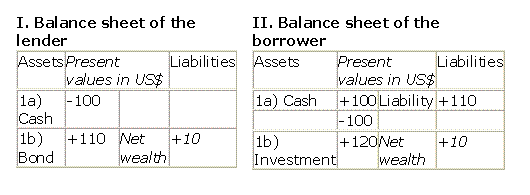
V. Putting credit derivative markets into perspective
The example might help in putting into perspective the breathtakingly strong growth of the credit derivative market. A credit derivative (in the form of, for instance, a credit default swap, total return swap, or credit linked note) is a contractual transfer of the risk of a credit from one market agent to another (without transfer of the underlying asset). Early forms of credit derivative are, for instance, financial guarantees.
The total market volume of credit derivatives outstanding was an estimated US$20.2 trillion in 2006, amounting to around 1.5 times annual nominal US GDP, up from just US$1.2 trillion seen in 2001 (Figure 2). The market is expected to grow further to US$33.1 trillion until 2008. In fact, the credit derivative market has become the biggest market segment of the international banking business already.
Figure 2. - Market volume credit derivatives, US$ trillion
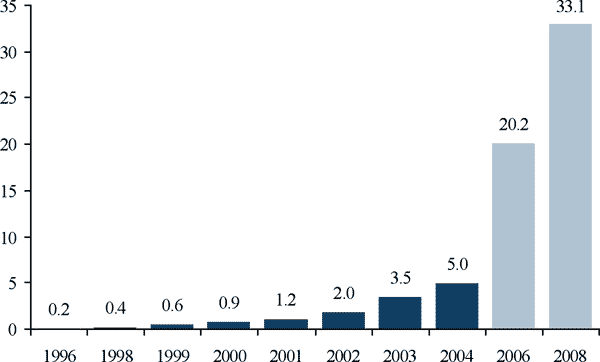
Source: British Bankers Association, Report 2006. - Estimates for 2006 and 2008.
Advances in terms of knowledge - both in financial mathematics and information technology - appear to have strongly contributed to the growth of the credit derivative market. Credit derivatives allow a more efficient trading, pricing, and allocation of existing credit risks among various market participants.
At the same time, the growth of the credit derivative market might also be a direct consequence of rapid government-sponsored credit growth. In fact, the rather pronounced increase in worldwide debt in recent years - and the accompanying net wealth gains expected on the part of lenders and borrowers - might have contributed strongly to a rising supply of and demand for credit derivatives.
Going back to our example, assume the aforementioned private lender wishes to hedge his or her bond holdings (balance sheet III). A protection against potential credit losses may cost, say, US$5 (2a). While such a purchase reduces the lender's net wealth to US$5 (2b), the reduction in portfolio risk might allow the lender to take on more credit risk.
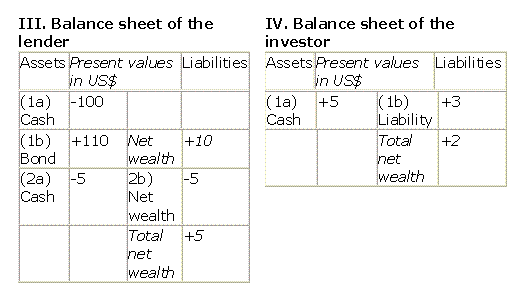
The seller of credit protection, in turn, receives the premium of US$5 (balance IV). Expecting the potential loss to be smaller than the premium received, the investor's liabilities increase by, say, US$3. As a result, the net wealth gain for the investor is US$2, potentially encouraging further demand for credit risk.
The admittedly simple example would suggest that expected gains from an expanding credit supply might have a direct bearing on individual market agents' propensity to take on additional credit risk via, for instance, credit derivative markets.
To be sure: there isn't anything wrong with new products and services emerging in a free market system. What Austrian economists would point out, however, is that credit derivative markets have emerged on the back of a government-controlled credit and money supply system. And as the latter is assumed to be crisis prone, credit derivative markets might be seen as a multiplier of the crisis potential inherent in today's monetary system.
VI. The way out of the Great Depression
An economy's growing exposure to credit raises the risk of a debt crisis. For instance, should returns fall short of expectations, borrowers could no longer service their debt. This, in turn, would reduce lenders' willingness or ability to provide additional credit. As the flow of liquidity dries up and borrower default spreads, aggregate demand declines, prices start falling, leading to recession and deflation.
It doesn't take much to see the risk that such a downward spiral, once set into motion, could be intensified if sellers of credit insurances find their own financial position deteriorating, in the extreme case to the point of eliminating their ability to deliver on contractual obligations.
Experience provides evidence that a collapsing credit boom, if it runs its full course, can entail indeed dramatic, even traumatic, economic, social, and political crisis. The "Great Depression" in 1929 to 1933 is perhaps the most prominent case of a credit boom gone wrong.
The US Dow Jones Industrial stock market index fell from 380 points in August 1929 to less than 44 points in June 1932 (Figure 3 (a) and (b)). From October 1929 to April 1933, the nominal US money stock fell nearly 29%; in real terms - that is the nominal stock of money deflated by the producer price index - the money stock dropped still a massive 20%.
Figure 3. - US Dow Jones, money and gold, 1920 to 1956
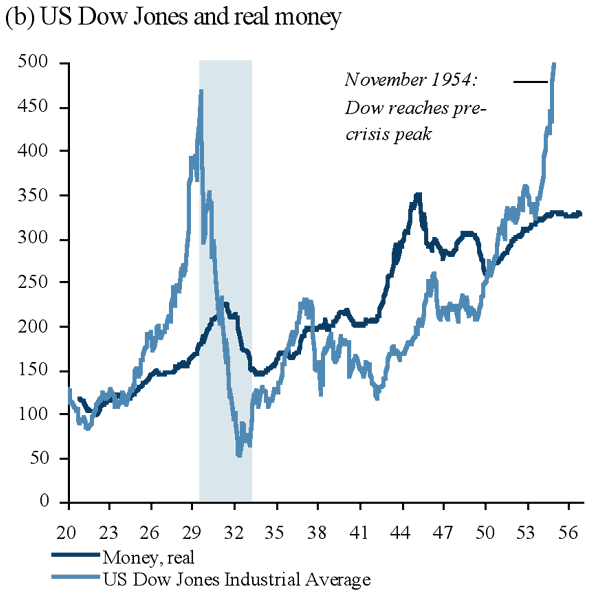
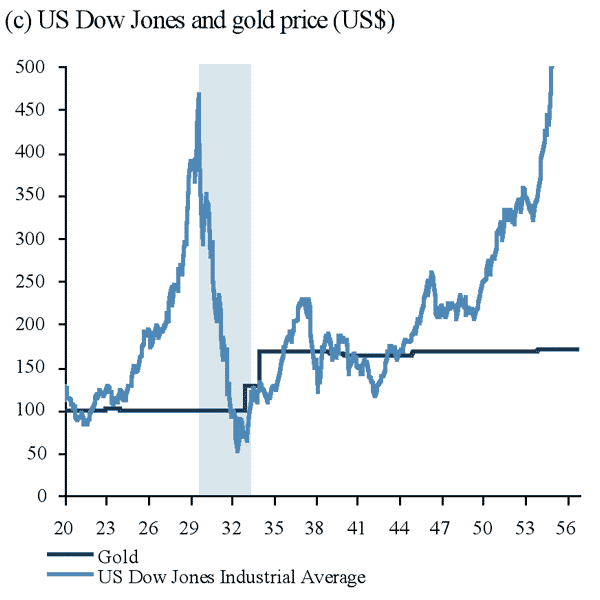
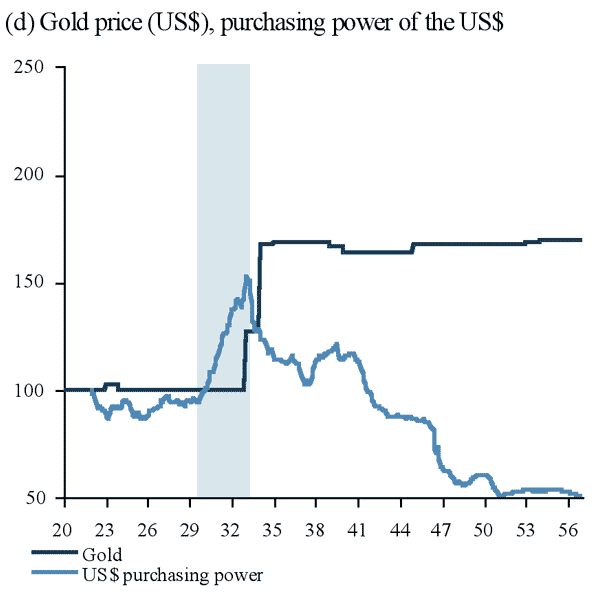
Source: Bloomberg; own calculations. Shaded period: October 1929 to March 1933. Dow and gold price series indexed (January 1922 = 100). Gold price in US$ per ounce. Purchasing power of the US$: reciprocal value of the producer index.
The price per ounce of gold in US dollar terms was kept broadly stable at US$20.67 until 1933 (Figure 3 (c)). Then, US President Franklin D. Roosevelt devalued the US dollar vis-à-vis gold in stages and finally fixed it at US$35 an ounce in early 1934.
However, the purchasing power of the US dollar - calculated as the reciprocal of the US producer price index - rose as prices kept declining (Figure 3 (d)), from the end of 1929 to spring 1933 by around 58%.
Finally it seems important to note that the way out of the Great Depression was accompanied with a debasing of the greenback versus gold, and that it didn't take long until money prices started rising, translating into an ongoing loss in the exchange value of the US dollar versus vendible goods and services.
In sum, the Great Depression episode might indeed lend support to the Austrians concern that, once a credit crisis unfolds, the value of money is going to suffer. What is more, any such crisis would open the doors for government interventionism, seriously endangering the very principles on which the free society rests.
VII. Why Austrians call for a return to free-market money
Austrians maintain that international monetary affairs have entered a vicious cycle: a credit boom, epitomized by a relentless expansion of circulation credit and money supply that is bound to collapse at some point. That said, could the world then enter a period of deflation, comparable to the scale of output and employment losses witnessed in the early 1930s of the 20th century?
As things stand it seems that inflation rather than deflation remains the real danger. Whatever the relative costs and benefits of inflation and deflation might be, deflation is now feared much more than inflation. And indeed it seems that the path the Great Depression took had much to do with the monetary and economic paradigms prevailing back then.
Anna Jacobson Schwartz and Milton Friedman wrote in their famous book A Monetary Historic of the United States, 1867-1960 that the US Federal Reserve […] was operating in a climate of opinion that in the main regarded recessions and depressions as curative episodes, necessary in order to purge the body economy of the aftereffects of its earlier excesses. […] regarded it as desirable that the stock of money should respond to the "need of trade," rising in expansion and falling in contractions; and attached much grater importance to the maintenance of the gold standard and the stability exchange rates than to the maintenance of internal stability.
Today, as soon as the credit pyramid showed the slightest signs of potential unwinding, central banks would be pressed to lower interest rates. This is because the public at large sees lower borrowing costs as a remedy against crisis - rather than its cause. What is more, highly indebted social groups have a preference for inflation, and an aversion to deflation. That said, a highly leveraged society might even be ready to accept a deliberate policy of ("controlled") inflation rather than agree to a period of declining prices.
Critics of the Austrian School might argue: The rise in credit growth and debt ratios has been going on for decades now. Credit has been expanding, but so have incomes and real wages. In fact, no major disaster, at least not on the scale predicted by Austrian economists, has occurred so far. Isn't there a flaw in their theory?
The answer, say the Austrians, is that it is still too early to reject their prediction as false.
In fact, the credit boom is not, in the words of Murray Rothbard, a "one shot":
It proceeds on and on, never giving the consumers the chance to reestablish their preferred proportions of consumption and saving, never allowing the rise in cost in the capital goods industries to catch up to the inflationary rise in prices. Like the repeated doping of a horse, the boom is kept on its way and ahead of its inevitable comeuppance by repeated and accelerating doses of the stimulant of bank credit. It is only when bank credit expansion must finally stop or sharply slow down, either because the banks are getting shaky or because the public is getting restive at the continuing inflation, that retribution finally catches up with the boom.
Seeking to prevent the final crisis — which would most likely entail a debasing of the currency — Mises concluded : "The alternative is only whether the crisis should come sooner as the result of a voluntary abandonment of further credit expansion, or later as a final and total catastrophe of the currency system involved." [10] Being fully aware of the dark side of the credit boom — that is its socially destructive ramifications — Mises argued for returning to free-market money, which he saw as the only monetary regime that would allow preserving the ideal of the free society. .
Thorsten Polleit is Honorary Professor at the Frankfurt School of Finance & Management. Send him mail . See his archive . Comment on the blog .
Notes
[1] Rising debt ratios are not necessarily confined to a government paper-money standard. In fact, they might also emerge under a commodity, or gold, standard. However, under the latter the rise in debt would presumably be much more restricted: as the demand for credit rises, so would the interest rate, restraining credit demand. Under a government's paper-money regime, however, the restricting mechanism is usually much less pronounced, or even absent: after having set official interest rates ("interest rate targeting"), central banks supply virtually any credit quantity demanded.
[2] In this context see, for instance, International Monetary Fund (2004), "Are Credit Booms in Emerging Markets A Concern?" World Economic Outlook , Chapter IV, pp. 1–20.
[3] Mises distinguished between two types of credit: "commodity credit" and "circulation credit." Given an unchanged stock of money in the economy, credit represents a transfer of money from one market agent to another; overall monetary demand does not change. If, however, the increase in credit is accompanied by a change in the money stock which, in turn, is decoupled from the economy's productive capacity (as is usually the case under a government-controlled money-supply regime), the granting of credit de facto increases the monetary demand over existing resources ("circulation credit"). See Mises, L. v. (1996), Human Action , 4th Revised Edition, Fox & Wilkes, San Francisco, pp. 433.
[4] Usually, the discussion is confined to government debt. But there were exceptions. In the second half of the 1980s, for instance, former Fed chairman, Paul A. Volker, expressed concerns about the consequences for financial stability in view of a general rise in indebtedness. See Volker, P.A. (1986), "The Rapid Growth of Debt in the United States," Federal Reserve Bank of Kansas City Review , Vol. 71, No. 5, pp. 3–12; in this context see also, for instance, Davis, E.P. (1987), "Rising Sectoral Debt/Income Ratios: A Cause For Concern?" BIS Economic Papers , No. 20, June.
[5] Mises, L. v. (1996), Human Action , 4th Revised Edition, Fox & Wilkes, San Francisco, p. 573.
[6] For further explanations of the structure of credit derivatives see, for instance, Kiff, J., Morrow, R. (2000), "Credit Derivatives," Bank of Canada Review , Autumn, pp. 3–10. For thoughts about the implications for financial markets see, for instance, Geithner, T.G. (2006) "Implications of Growth in Credit Derivatives for Financial Stability," Remarks at the New York University Stern School of Business Third Credit Risk Conference, New York City, 16 May.
[7] For instance, Eichengreen and Mitchener concluded that "[…] the credit boom view provides a useful perspective on both the boom of the 1920s and the subsequent slump." See Eichengreen, B., Mitchener, K. (2003), "The Great Depression as a Credit Boom Gone Wrong," BIS Working Paper , N. 137, September.
[8] Friedman, M., Schwartz, A. J. (1963), A Monetary History of the United States 1867–1960 , National Bureau of Economic Research, p. 691.
[9] Rothbard, M.N. (2006), For a New Liberty, The Libertarian Manifesto , 2nd Edition, Ludwig von Mises Institute, Auburn, Alabama, pp. 236.
[10] Mises, L. v. (1996), Human Action , 4th Revised Edition, Fox & Wilkes, San Francisco, p. 572.
You can receive the Mises Daily Article in your inbox. Go here to subscribe or unsubscribe .
© 2005-2022 http://www.MarketOracle.co.uk - The Market Oracle is a FREE Daily Financial Markets Analysis & Forecasting online publication.




